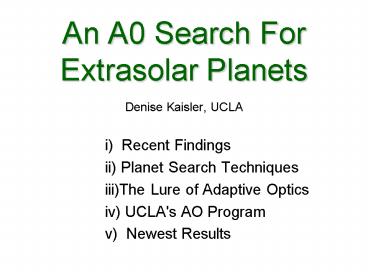An A0 Search For Extrasolar Planets - PowerPoint PPT Presentation
1 / 23
Title:
An A0 Search For Extrasolar Planets
Description:
An A0 Search For Extrasolar Planets. Denise Kaisler, UCLA. i) Recent Findings ... sensitive to the planets that vrad searches are unlikely to detect ... – PowerPoint PPT presentation
Number of Views:72
Avg rating:3.0/5.0
Title: An A0 Search For Extrasolar Planets
1
An A0 Search For Extrasolar Planets
- Denise Kaisler, UCLA
- i) Recent Findings
- ii) Planet Search Techniques
- iii)The Lure of Adaptive Optics
- iv) UCLA's AO Program
- v) Newest Results
2
Planets or Brown Dwarfs?
- the distinction is given in terms of mass
- MBD 10 - 80 MJ , MP
- but formation process (rather than mass)is
thought to be the key to telling them apart - many search techniques are sensitive to both
- the generic term "substellar companions" is often
used to discuss both
3
Discoveries As of Today (May 18)
- 42 exoplanets
- 1 triple system
- 3 planets of M
- three classes of planets
- e (56)
- p (36)
- c (9)
- 1 unambiguous measurement of MP
- Americans are narrowly leading the Swiss in the
planet detection game - It's now possible to detect a planet of Jupiter's
mass and orbital radius around a sun-like star
4
Planet Search Techniques
- Radial Velocity Measurements
- Pulsar timing
- Astrometry
- Photometry
- Gravitational Microlensing
- Interferometry
- Adaptive Optics (AO)
5
Radial Velocity Measurements
6
Eccentricity of EGPs
7
Pulsar Timing
- Companions perturb a pulsar's extremely regular
beats. - In 1991, a 3 objects ME were detected around a
pulsar in Virgo. - Many astronomers remain skeptical that these are
in fact planets
8
Gravitational Microlensing
9
The Lure of AO
- sensitive to the planets that vrad searches are
unlikely to detect - higher resolution than unaided observations
- (diffraction-limited ? 1.22?/D)
- allows imaging
- technology more mature than interferometry
10
Why Planetologists Should Get Excited
- Keck AO shows Neptune's methane clouds and allows
a calculation of the optical depth of the
atmosphere. High reflectance consistent w/
hydrocarbons or large ice grains.
11
The Essence of AO Systems
- AO systems remove distortions introduced by the
Earth's turbulent atmosphere - real-time corrections are done by a wavefront
sensor (WFS) connected to a deformable mirror(DM) - actuators shape the DM so that the reflected
wavefront is planar
12
The Visible Difference
13
Schematic of the Visible Difference
14
A Typical AO System
15
Measuring AO Performance
- the critical quantity is the Strehl Ratio
- typical Strehls vary from system to system
- Lick (3m, ?1.6µm) S 0.40
- Keck (10m, ? 1.6µm) S 0.25
16
UCLA AO Companion Search
- Zuckerman, Macintosh, Becklin, Kaisler
- search the environs of young (t (d
- distance fairly easy to determine
- but no single dependable diagnostic for stellar
ages (use Li, X-ray flux, chromospheric emission,
rotation rate, UV emission, and kinematics)
17
UC AO Facilities
- Shane 3-m (Lick Obs.)
- DM 127 actuators
- Detector 256x256
- Diff. Limit 0.1"
- Guide Star Brightness
- V
- Keck 10-m Telescope
- DM 319 actuators
- Detector 1024x1024
- Diff. Limit 0.04"
- Guide Star Brightness
- V
18
Sensitivity to Separation
19
Sensitivity To Mass/Age
20
First Results From Lick GJ 808.2
21
Hottest Results from Keck A0
- HD 171488
- M dwarf companion
- HD 57821
- M dwarf companion
- GL 559.1
- M/L dwarf companion with a mass near the H-fusion
limit possible brown dwarf
- TWA 5ABC
- brown dwarf confirmed spectroscopic binary
resolved for the first time - TWA 6B
- confirmed NICMOS detection of sub-stellar mass
possible planet
22
TWA 5ABC Imaged With Keck AO
- H-band (?1.6 µm), 1x60s, and 10x0.62s, ?AB 2",
?H AB 4 mag
23
To Do List for This Weekend
- fly out to Keck
- observe remaining TWA stars
- observe new list of specially selected stars from
Hipparcos catalogue, ones with good space motions
(-20youth indicators - talk with Bruce about how best to tackle the
unreduced data from previous Lick/Keck runs































